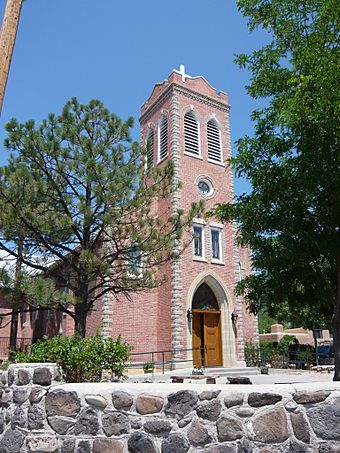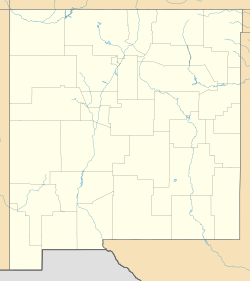Ohkay Owingeh, New Mexico facts for kids
|
Ohkay Owingeh
(San Juan Pueblo) |
|

San Juan Bautista Church
|
|
| Nearest city | Española, New Mexico |
|---|---|
| Area | 16.2 acres (6.6 ha) |
| Built | 1540 |
| NRHP reference No. | 74001201 |
Quick facts for kids Significant dates |
|
| Added to NRHP | July 30, 1974 |
Ohkay Owingeh is a special community in Rio Arriba County, New Mexico. It is home to the Pueblo people who are officially recognized as a tribe by the U.S. government. For many years, it was known by its Spanish name, San Juan Pueblo. In 2005, the community decided to return to its original name, Ohkay Owingeh.
Contents
What's in a Name?
Ohkay Owingeh was called San Juan Pueblo from 1589 until November 2005. The name Ohkay Owingeh comes from the Tewa language. It means "place of the strong people."
If you send mail there, the U.S. Postal Service prefers the name Ohkay Owingeh. However, they will also accept San Juan Pueblo. This community was also once formally known as the San Juan Indian Reservation.
Where is Ohkay Owingeh?
Ohkay Owingeh is located in New Mexico. It sits about 5,663 feet (1,726 meters) above sea level. The community is very close to Española. This is about 25 miles (40 km) north of Santa Fe.
A Look at History
The Ohkay Owingeh pueblo was first settled around the year 1200 AD. This was during a time called the Pueblo III Era. According to their traditions, the Tewa people moved here from the north. They may have come from the San Luis Valley in southern Colorado. This was part of a big movement of people that lasted into the Pueblo IV Era.
First Spanish Capital
In March 1598, a Spanish explorer named Juan de Oñate traveled north. He brought Catholic missionaries, soldiers, and colonists with him. They also brought many animals like cattle, sheep, and horses. On July 11, 1598, they arrived at a place called Yungeh. This is where Ohkay Owingeh is today.
The people living there were very welcoming. They offered their Yuque Yunque pueblo to Oñate and his group as a place to stay. The next day, on July 12, 1598, Oñate renamed a nearby pueblo, Caypa. He called it San Juan de los Caballeros after his patron saint, John the Baptist. This new name is what we know today as Ohkay Owingeh.
San Juan de los Caballeros became the very first capital of the Spanish region of Santa Fe de Nuevo Méjico. Local stories say that this event brought two families, Caypa and Yuque Yunque, back together. They had been separated by a river. When Yuque Yunque was offered to Oñate, the two pueblos became one again at Caypa. The Spanish capital later moved to Santa Fe in 1610.
A local man named Popé became a very important leader. He played a big role in the Pueblo Revolt of 1680. This was a major event in American Indian history.
Ohkay Owingeh Today
Ohkay Owingeh is the main center for the Eight Northern Indian Pueblos Council. The people of this pueblo belong to the Tewa ethnic group of American Indians. It is one of the largest pueblos where the Tewa language is spoken.
Every year, the Pueblo Feast Day is celebrated on June 24. On this day, a Catholic mass is held in the morning. This is because of the historical ties between the pueblos and the Catholic Church. Most Pueblo people practice both Catholic and traditional Pueblo beliefs. The tribe also owns the Ohkay Casino. They also have the Oke-Oweenge Crafts Cooperative. This cooperative shows off beautiful redware pottery, weaving, painting, and other art from the eight northern pueblos.
Who Lives There?
In 2017, about 1,480 people were estimated to live in the main community area. The wider surrounding area had about 6,690 people. The 2010 census showed that 1,522 people in the U.S. said they were only Ohkay Owingeh. Another 1,770 people identified as Ohkay Owingeh, either alone or with another group.
Learning and Education
Ohkay Owingeh is part of the Española Public Schools district. Students attend Española Valley High School for their public high school education.
Famous People from Ohkay Owingeh
Many talented people have come from Ohkay Owingeh, including:
- Emiliano Abeyta, a painter
- Juan B. Aquino, a painter
- Robert Aquino, a painter
- Lorencita Atencio, a painter and textile artist
- Joe A. Garcia, a tribal governor and councilman
- Rose Gonzales, a potter
- Evelina Zuni Lucero, a writer
- Esther Martinez, a linguist and storyteller
- Popé, a Tewa leader of the Pueblo Revolt of 1680
- Alfonso Ortiz, a professor and cultural anthropologist
- Leonidas Tapia, a potter
See also
 In Spanish: Ohkay Owingeh para niños
In Spanish: Ohkay Owingeh para niños




